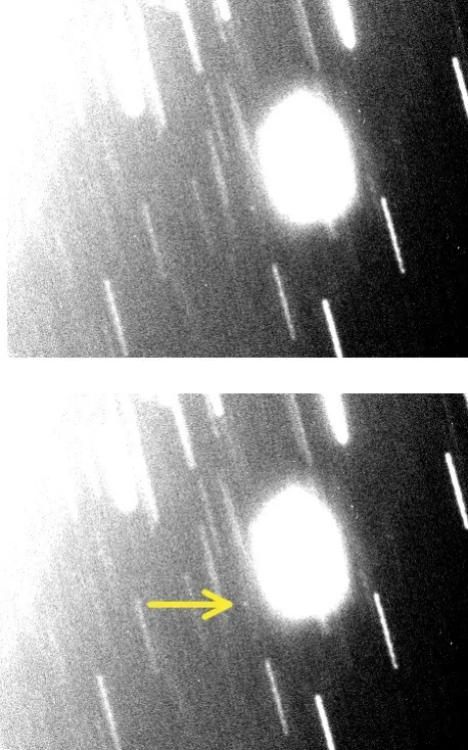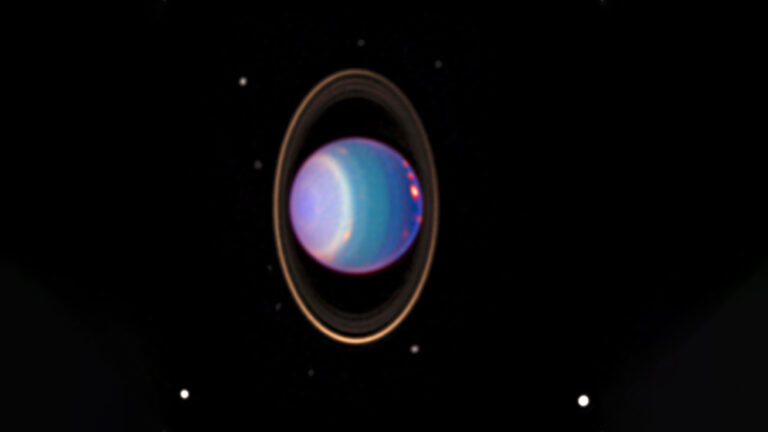Neptune has two new satellites, and Uranus has one.
It can be easy to forget that we do not yet know everything there is to know about our own little piece of the world while we continue to investigate the mysteries of faraway corners of the universe. Scientists from the Minor Planet Center of the International Astronomical Union have confirmed the existence of three newly discovered moons in our solar system. One of these moons orbits Uranus (as shown above), and the other two circle nearby Neptune.
The newly discovered moon of Uranus has been given the preliminary designation of S/2023 U1, but it will eventually be given a Shakespearean name, just like the other moons of the planet, some of which may have oceans beneath their surface. In order to complete its long, elliptical orbit, it takes 680 days to travel around the sun. Not only does this make it more difficult to locate, but it is also quite small, measuring only 8 kilometers in circumference.
It was necessary to make a large number of observations and employ specialized image-processing techniques in order to identify S/2023 U1 and the other newly discovered moons, as stated by Scott Sheppard of the Carnegie Institution for Science. Both of these moons are extremely dim. It was in the latter half of 2023 when Sheppard made the initial discovery of S/2023 U1 using Carnegie’s Magellan telescope at the Las Campanas Observatory in Chile. In the subsequent month, he continued his investigation and gathered further photos that contributed to the determination of the moon’s orbit. In addition, he verified that the S/2023 U1 was captured in the Magellan photographs of 2021.
Additionally, Sheppard was the one who was responsible for identifying the more brilliant of Neptune’s two new satellites, which is today referred to as S/2002 N5. It takes nine years for it to orbit Neptune, and its diameter is 23 kilometers. It is once again the Magellan telescope that is responsible for this detection. In spite of the fact that Uranus’ new moon is smaller, it was much simpler to locate due to the fact that the planet is getting closer. The larger of Neptune’s new moons, on the other hand, was a significantly more difficult obstacle to overcome.
Sheppard collaborated with David Tholen of the University of Hawaii, Chad Trujillo of Northern Arizona University, and Patryk Sofia Lykawa of Kindai University in order to determine the identity of the extremely weak Neptunian moon that is now known as S/2021 N1. It was in the year 2021 when S/2021 N1 was first observed by the Subaru telescope. Using this information, the crew was able to direct the Magellan telescope in the manner that would allow them to capture the moon once more in the years 2022 and 2023. On the other hand, it was so weak that subsequent observations with the Very Large Telescope of the European Southern Observatory and the 8-meter telescope of the Gemini Observatory were required in order to confirm it. The circumference of this moon is only 14 kilometers, and it takes roughly 27 years for it to complete one circuit around the sun.

It is a fairly typical occurrence for new moons to be discovered in the solar system. In recent times, scientists have discovered new satellites that orbit both Jupiter and Saturn. According to the Carnegie Institution for Science, the new observations most certainly bring the total number of moons around Neptune down to 14 kilometers, and they bring the total number of moons orbiting Uranus down to approximately 8 kilometers from one another. Jupiter, on the other hand, is finished to a distance of around 2 kilometers.
It is possible for scientists to gain a better understanding of how things formed in the early chaotic ages if they have a complete list of the moons in the solar system. A comparison can be made between the orbits of the newly discovered moons and those of the outer satellites that circle other planets, such as Jupiter and Saturn. Based on the groups, it appears that primordial “parent moons” may have torn apart, resulting in the formation of fragmented moons. With the technology that is available now, it is possible that there are many more fragments floating about out there, but they are too faint to detect. In the next years, we might be able to get a better look at the array of moons that orbit Uranus and Neptune because there are preliminary plans for robotic expeditions to investigate each of these planets.

